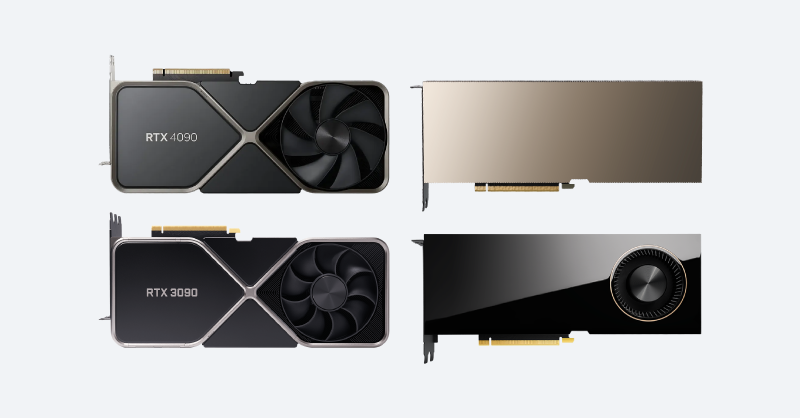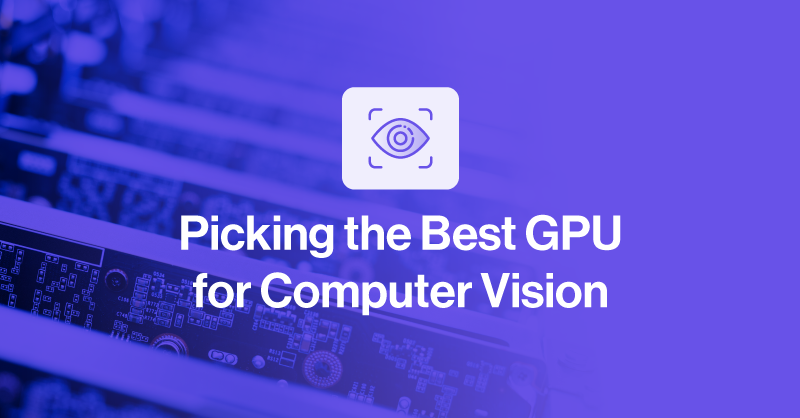Why Use a GPU for Training a Computer Vision AI Model?
GPU acceleration is utilized for training computer vision AI models due to its ability to significantly enhance the speed and efficiency of training AI.
From facial recognition to monitoring crops, machine-learning models are being used to carry out a growing number of computer vision related tasks. Training these models typically requires a large datasets of images or videos, which are translated into matrices of values reflecting properties such as pixel color and intensity, and other defined values that can be understood by computers.
With tens of thousands of specialized cores employing parallelized computing of large scale matrix operation, GPUs fit the bill for powering neural networks that crunch numbers constantly to draw conclusions, make predictions, and learn iteratively by repeating the process of computer vision.
AMD or NVIDIA GPUs in 2023?
Although there are both AMD and NVIDIA are prominent GPUs options, if you’re looking to train a machine learning model choosing an NVIDIA GPU is typically the best choice due to the maturity of NVIDIA’s CUDA API for parallel computing, as well as the presence of Tensor Cores NVIDIA cards utilize for AI tasks. However, AMD is make strides to accelerating AI capabilities in their GPUs with the inclusion of AI cores in their newest AMD Radeon RX 7000 series GPUs and continuing to build their ROCm .
NVIDIA Tensor Cores are specialized silicon, tailored to handling common tasks in machine learning inference and training, such as matrix multiplications. Mid-range NVIDIA cards from the past three consumer generation (40-series, 30-series, and 20-series GeForce) are all suitable for training computer vision models and include Tensor Cores, users looking to do more than dabble with machine learning should choose a card from the NVIDIA professional RTX line of GPUs, formally known as Quadro.
NVIDIA RTX GPUs such as the RTX 6000 Ada, use the same GPU chips as GeForce RTX GPUs but deliver a more stable and professional experience with lower clock speeds, higher memory capacity, and scalability for multi-GPU configurations. However, an RTX card is not the end-all-be-all, and consumer GeForce can still perform well for smaller more experimental developments.
Which GPU for Computer Vision.
- For small scale and individual enthusiasts - GeForce RTX 4080 and RTX 4090
- For medium/larger scale operations - RTX 6000 Ada and RTX 5000 Ada
- Peak enterprise deployments - NVIDIA H100
For individuals wanting to explore Computer Vision AI, RTX 4080, and RTX 4090 are high performance consumer GPUs that fit the bill as the best bang for your buck for training small scale AI. This means that your gaming system right now can be used to test and explore the capability of image recognition and computer vision models.
However, for the larger scale deployments, the RTX 6000 Ada, and RTX 5000 Ada are the choice GPU since they can be outfitted in a multi-GPU setup in workstation or server delivering fast throughput. Since the RTX line of GPUs are 2 slot width instead of the 3.5 slot width design in the 4080 and 4090, deploy up to 4 NVIDIA RTX GPUs in workstations and up to 8 in servers for extreme performance, reduced train times, and increased inferencing throughput.
Lastly is the NVIDIA H100 GPU which is very expensive for an individual. The H100 is not a GPU designed individuals but instead for large enterprise deployments that are looking for the best performance and the best scalability.

What Specifications to Look for in a GPU for Training AI?
When selecting a GPU for computer vision tasks, several key hardware specifications are crucial to consider. The choice of GPU can significantly impact the performance and efficiency of your computer vision models.
- Cores: NVIDIA CUDA Cores represent the number of parallel processing units in the GPU for handing the computing. More cores generally mean better performance.
- Tensor Cores: Tensor cores are designed to accelerate the matrix multiplication operations.
- Video Memory: The amount of VRAM on the GPU will tell you the size of the model that can fit on the GPU before having to go back to drive storage. By being able to store and execute calculations on data stored on the GPU memory is more efficient.
- Memory Bandwidth: Along a large memory buffer, the bandwidth translates to the speed the GPU can deliver the data back to the CPU. Faster data transfer between the GPU and its memory is important for handling the large amounts of data involved in real-time computer vision.
- Clock speed: Clock speed can affect the speed in which calculations are performed. However, there can be a trade-off between heat and efficiency versus clock speeds. Some GPUs opt for lower clocks in return for more memory and higher bandwidth. This is the case between the RTX 4090 and the RTX 6000 Ada which share the same GPU chip but differ in memory, stability, scalability, TDP, and more.
It's important to consider your specific requirements and budget when selecting a GPU for computer vision. Additionally, stay informed about the latest GPU releases and reviews, as advancements in GPU technology occur regularly. Keep SabrePC in mind to keep up with news and other technical blogs we release in the future! If you’re looking to build a workstation or supply your deployment with the proper computing, explore our customizable workstations and servers for Deep Learning and AI. If you have any questions, get in touch with our experienced team for recommendations for your intended workload.


